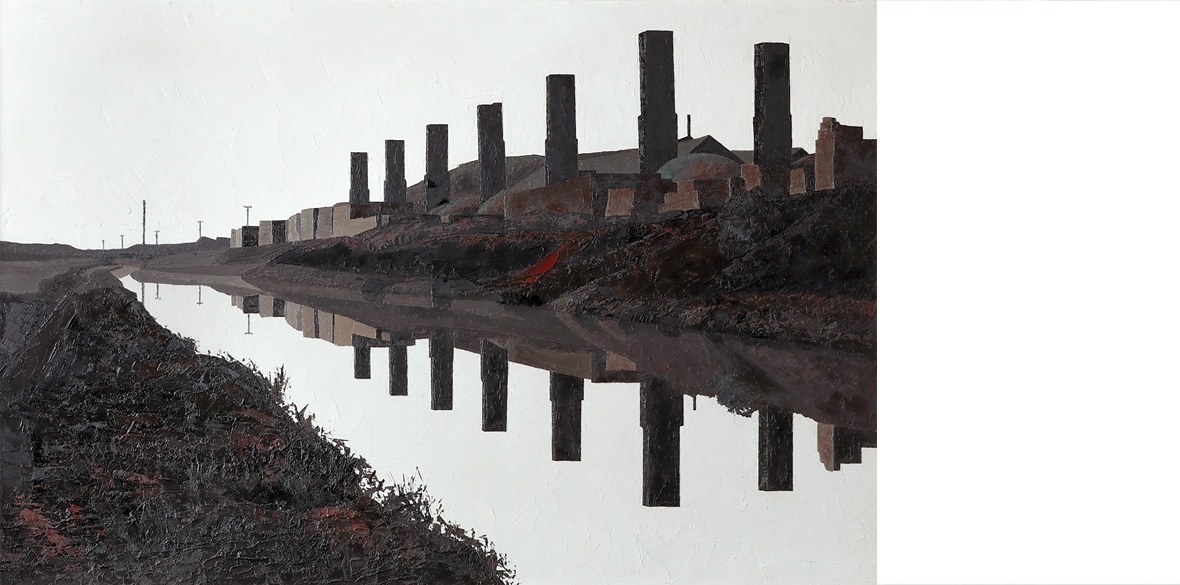This is the last article you can read this month
You can read 5 more article this month
You can read 5 more articles this month
Sorry your limit is up for this month
Please help support the Morning Star by subscribing here
Maurice Wade: Silent Landscapes
The Andy McCluskey Collection
Trent Art, Newcastle
TWENTY-FIVE years before Morrissey, Maurice Wade contemplated the urban cityscape of Stoke on Trent as though every day were like Sunday.
These paintings, “silent and grey,” are the visual midwife of Morrissey’s reactionary miserablism. They render the city as though it were made entirely of ash, and entirely devoid of people. They are painfully beautiful.
In the 1960s and ’70s, Wade made at least 350 such paintings in a sustained act of love and aggression towards the city he lived in. All the images were drawn from subjects within walking distance of his own home.
For a working-class artist to make a vision of his neighbourhood was hardly a new phenomenon in the north: before Wade’s version of Stoke came LS Lowry’s version of Pendlebury, Lancashire. The difference is the 30 years that divide them, and the gigantic shift in global perspective of World War II.
Lowry’s factories are a 19th-century phenomenon. They contribute to the imperial economy, and Lowry’s people (who don’t cast shadows, interestingly) are underpaid and oppressed, but employed, busy and full of communal identity.
In contrast, Wade’s potteries, factories and terraced houses are museum pieces, redundant anachronisms in a world whose technological economy has moved on. They exist in an existential twilight, however bright the sky.
The combination of a world in shadows and a bright sky is a key motif for Wade.
For Magritte, who invented the motif, the view of buildings at night under a sunny midday sky was a delicious paradox, a mental luxury. His renditions of this effect (he called his own series The Empire of Lights) are like the illustrations of a bizarre fairy tale. You can imagine people inside them: street lights are on and widows are illuminated.
Wade treats this same surrealistic paradox with no trace of playfulness. He eliminates sentimentality, just like he eliminates people. Rather, he brings post-apocalyptic clarity to the environments of working-class life.
“Come Armageddon,” sings Morrissey. Come come, nuclear bomb. Is it the threat of mutually assured destruction – the 1962 Cuban Missile crisis, for example – that drains colour, humanity and empathy from Wade’s vision?
Born in 1917, Wade was the son of a gas fitter. Graduating from art school, he served in the army from 1939-1946 and thereafter was a primary school art teacher. After some success as a painter, eventually he opened his own art gallery and collected the British champions of post-Impressionism, the Futurists Wydham Lewis and the lesser known working-class artist William Roberts.
There is not, it seems, a single photograph of Maurice Wade, and very little biographical information. But the artists he collected are a clue to the context and the decisions that are the genesis of his own vision.
Lewis and Roberts were artists for whom Cezanne’s post-Impressionist formalism was a doctrine: the reduction of the subject to the geometrical simplicities of cone, cylinder and sphere. They were among the futurists who had taken these tools and used them to celebrate modernity: technology, speed and warfare.
Wade was for sure familiar with the aspiration as well as the tragic destiny of futurism. Yet, after another war, Wade surveys the past, the industrial city, with the tools of yesterday’s future.
To re-deploy the analytical method of post-Impressionism was a deliberate strategy. He referred to it as “hard formalism with an emphasis on geometrical shapes and sombre-toned colours” that to Wade “best interpreted the particular character of the situation.”
But what situation, exactly?
Politically, the images reflect the absence of ideals. The achievement is a combination of perfection, and futurelessness – futurism, but with no optimism and no prospects. It is as though, as a literate and educated artist, Wade had powerful tools of analysis, but in the meantime the subject had died.
This kind of post-war modernist formalism is akin to the drama of Samuel Beckett: it is an endgame, a cul-de-sac. It depicts a dead end, perfected and devoid of meaning.
Wade talks about it in near psychological terms: “Over and above the evident stillness,” he writes, “it is sufficient if one can convey the presence of a human sensibility, a real meaning, a glance.”
This “human sensibility” is his real subject, but what kind of sensibility? Whose is this glance at the world without optimism or sentiment, which has only a perfected play of tones? What kind of human sees a world reduced to shadows?
So – antecedent to Morrissey’s miserablism comes this very particular northern phenomenon. Its roots lie in post-Impressionism but it has abandoned the future, and it wants no truck with Futurism’s revolutionary ambition. Let’s call it Depressionism: vision without illusions.
Like Beckett, such art shouldn’t be seen as symptomatic of mental illness, but as a kind of medicine, a caustic warning.
The paintings are visual manoeuvres in the dark, and the harbingers of Goth and Doom. And Depressionism, quite rightly, has its champions. These paintings are the property of Andy McCluskey, the 1980s pop star whose masterpiece Enola Gay is a meditation on the intentions of the pilot who dropped the atom bomb.
Ends April 29 2022. Free.










